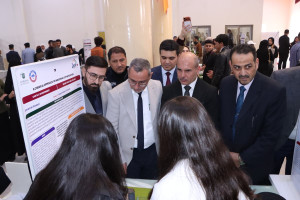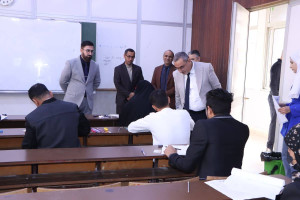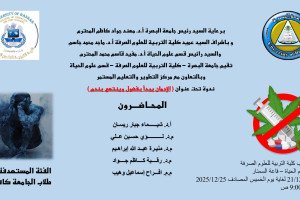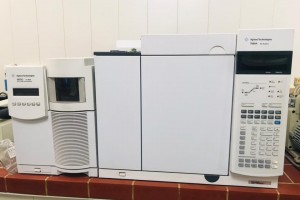
The College of Education for Pure Sciences at the University of Basrah discussed a master's thesis entitled (A study of some chemosynological characteristics of the skeletal muscles of two types of pelagic fish in Basrah Governorate)
The message presented by the researcher (Karar Hassan Salman) included
The present study conducted a comparative study on two types of bony fish belonging to the Mugilidae family, namely (Day, 1888) Planiliza klunzingeri locally known as (Planiliza klunzingeri) and Planiliza subviridis (Valenciennes, 1836) locally known as green perch, to study some of the chemo-muscular characteristics. structure (red and white) in two areas (R1 and R2) in the body of the above-study fish to calculate and measure the diameters, number and area of muscle fibers, as well as estimate the protein concentration in their muscle fibers using the BCA assay method (Bicinchoninic Acid), as well as estimate the concentration and proportions of both amino and fatty acids in Its muscle fibers, which are associated with the locomotor and nutritional activities of the fish of the current study, were collected from the Faw / Breakwater area within the Iraqi territorial waters during the period between March and June / 2022, using the method of fishing by surrounding and netting.
The results of calculating the diameters of red and white muscle fibers are shown
The current results for calculating the numbers of red and white muscle fibers showed that there were two different relationships (increase and decrease) in the numbers of red and white muscle fibers in the R1 and R2 regions of the body.
R2 compared to the R1 area,
As for the results of the area of red and white muscle fibers, the current study indicated a difference in the values of the averages of the area of red and white muscle fibers in the R1 and R2 body regions and in the two studied species.
As for the results of protein concentration in red and white muscle fibers, the results showed a significant increase in the values of protein concentration rates in white muscle fibers compared to red muscle fibers for both body regions and for the two studied species. By P.klunzingeri,
The concentrations of amino acids for the two studied species were estimated using the High-Speed Amino Acid Analyzer, as the results of the current study indicated that 16 amino acids (nine essential amino acids (EAA)) were recorded, namely (arginine, histidine, isoleucine, leucine, lysine, and methionine). , phenylalanine, threonine, valine) and three of them represent the branched chain amino acids (BCAAs) which are (isoleucine, leucine and valine) and seven non-essential amino acids are (alanine, cysteine, glutamic, glycine, proline, serine, tyrosine) The current results also showed a discrepancy in the values of their concentrations and ratios between the two studied species and in the study areas R1 and R2.
The results of estimation of the concentration and proportions of fatty acids in fish muscles using a Gas Chromatographic-Mass (GC-Mass) LC-10A Shimadzuh apparatus indicated that
Six fatty acids were recorded, divided into two groups according to their chemical properties, which are saturated fatty acids (SFA), which included Palmitic acid (C16:0), Palmatolic acid (C16:1), Stearic acid (C18:0), and Unsaturated fatty acids. Unsaturated fatty acids Mono((MUSFA) which included Oleic acid (C18:1) and unsaturated fatty acids Poly(PUSFA) which included Linolenic acid (ω3) (C18) :3) and Linoleic acid (ω 6) (C18:2))
Conducting comparative studies dealing with the study of some histological characteristics and comparing the area and numbers of red and white muscle fibers in bony fishes from different environmental locations due to the lack and scarcity of studies on them.
And conducting more specialized histological studies to know the numbers of mitochondria in the red and white muscle fibers in the muscles of bony fish of different locomotor activity.
And conducting studies dealing with knowing the concentrations of amino and fatty acids in different bony fishes, in addition to conducting comparative studies between bony fishes and some other vertebrates to find out the similarities and differences in the concentrations of amino and fatty acids in their muscle fibers.
And conducting comparative studies dealing with the concentration of proteins in bony fish with environmental sites (marine and river).








